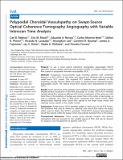Polypoidal Choroidal Vasculopathy on Swept-Source Optical Coherence Tomography Angiography with Variable Interscan Time Analysis
Author(s)
Rebhun, Carl B.; Moult, Eric Michael; Novais, Eduardo; Moreira-Neto, Carlos; Ploner, Stefan B; Louzada, Ricardo N.; Lee, Byungkun; Baumal, Caroline R.; Fujimoto, James G; Duker, Jay S.; Waheed, Nadia K.; Ferrara, Daniela; ... Show more Show less
DownloadPublished version (1.165Mb)
Terms of use
Metadata
Show full item recordAbstract
Purpose: To use a novel optical coherence tomography angiography (OCTA) algorithm termed variable interscan time analysis (VISTA) to evaluate relative blood flow speeds in polypoidal choroidal vasculopathy (PCV). Methods: Prospective cross-sectional study enrolling patients with confirmed diagnosis of PCV. OCTA of the retina and choroid was obtained with a prototype swept-source OCT system. The acquired OCT volumes were centered on the branching vascular network (BVN) and polyps as determined by indocyanine-green angiography (ICGA). The relative blood flow speeds were characterized on VISTAOCTA. Results: Seven eyes from seven patients were evaluated. Swept-source OCTA enabled detailed enface visualization of the BVN and polyps in six eyes. VISTA-OCTA revealed variable blood flow speeds in different PCV lesion components of the same eye, with faster flow in the periphery of polyps and slower flow in the center of each polyp, as well as relatively slow flow in BVN when compared with retinal vessels. BVNs demonstrated relatively faster blood flow speeds in the larger trunk vessels and relatively slower speeds in the smaller vessels. Conclusions: Swept-source OCTA identifies polyps in most, but not all, PCV lesions. This limitation that may be related to relatively slow blood flow within the polyp, which may be below the OCTA’s sensitivity. VISTA-OCTA showed heterogeneous blood flow speeds within the polyps, which may indicate turbulent flow in the polyps. Translational Relevance: These results bring relevant insights into disease mechanisms that can account for the variable course of PCV, and can be relevant for diagnosis and management of patients with PCV. Keywords: OCTA; optical coherence tomography angiography; PCV; polypoidal choroidal vasculopathy; variable interscan time analysis
Date issued
2017-11Department
Massachusetts Institute of Technology. Department of Electrical Engineering and Computer Science; Massachusetts Institute of Technology. Research Laboratory of Electronics; Massachusetts Institute of Technology. Institute for Medical Engineering & ScienceJournal
Translational Vision Science & Technology
Publisher
Association for Research in Vision and Ophthalmology (ARVO)
Citation
Rebhun, Carl B. et al. "Polypoidal Choroidal Vasculopathy on Swept-Source Optical Coherence Tomography Angiography with Variable Interscan Time Analysis." Translational Vision Science & Technology 6, 6 (November 2017): 4 © 2017 The Authors
Version: Final published version
ISSN
2164-2591